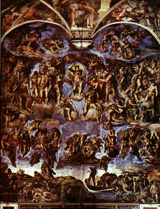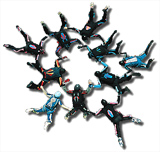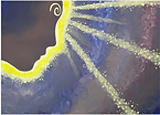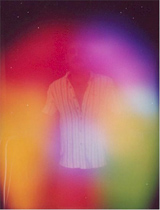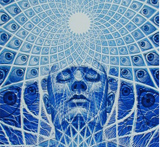The subliminal — a new dimension of personality
Editor’s note
Besides the ‘unconscious’ of psychoanalysis, Sri Aurobindo describes two planes of consciousness — the superconscient and the subliminal. The subliminal self is the inner being that stands behind the surface personality and is the meeting ground of the universal and the individual. The subliminal itself is supported by the soul-principle. Though the surface being of the average individual is largely influenced by the subconscient, it is also influenced to a significant extent by the subliminal.
Besides our usual life experiences that revolve around habitual physical, vital (emotional) and ideational reaction patterns, we are aware of a class of subtle experiences which defy logic. Yet, even when ignored, they continue to impose their presence. Thus early in the morning, one receives a warning to avoid refrigerated water for no rhyme or reason — it is just a ‘gut feeling’. The warning is too insignificant to be remembered till later in the day one catches a cold after having a chilled soda. An uncanny sense of danger before boarding a flight saves one from a plane crash. A doctor confronted with an acutely ill patient of septicemia has to take decisions before the results of laboratory tests come in. He relies on his intuition and experience to choose the correct medicine and he succeeds. Again it is not an uncommon experience to open a book and suddenly find the page we wanted to find — an act that saved the labour of rummaging through pages. At other times a sudden aberrant idea about a topic occurs to our mind which on subsequent confirmation from other knowledgeable sources is found to be strikingly true. Alexander Fleming discovered ‘accidentally’ what he always wanted to find by rational means. A piece of Beethoven’s music is suddenly in tune with an universal wavelength that cuts across all barriers of society, culture, race or language. In an inspired moment, slogans are uttered which like the mantra become powerful, dynamic, living and change the course of history — slogans like ‘Vande Mataram’, ‘Liberty-Equality-Fraternity’ or ‘Workers of the world Unite’.
There are many other subtle experiences. Happenings like clairvoyance and hypnosis are not solely explainable by the functionings of the outer senses. While the scientist is guided by intuition; the artist, poet, musician and visionary are guided by inspiration, as the occultist by inner senses. Besides, how does one explain the experiences of the NDE (Near Death Experience) subject? He is resuscitated from a technically terminal state and recounts having experienced a life-review and meeting Beings of Light. His ‘inner’ experiences (while outwardly he was in a comatose state) show that the concepts of ‘Judgment Day’ and ‘Angels’ are based not on fancy but on some ‘suprasensorial’ experience. Again, how does one explain a dream which contains future premonitions? It cannot be based on the ‘subconscious’ because that is a repository of ‘past experiences’.
Subliminal vs Subconscious
Sri Aurobindo refers all such subtle experiences to an intermediary plane of consciousness that stands behind the surface personality — the subliminal plane.(1) Ordinarily, the word ‘subliminal’ means ‘below the threshold’. Sri Aurobindo uses the term to describe a new plane of consciousness which holds within its sphere an ‘inner being’ with an ‘inner mind’, an ‘inner vital’ and a ‘subtle-physical’. This inner being is capable of a much vaster capacity of experience than our outer personality.
It is very important to differentiate this subliminal plane from the subconscious or what is known as the ‘unconscious’ in psychoanalysis.
“Ordinarily, we speak of a subconscious existence and include in this term all that is not on the waking surface. But the whole or the greater part of the inner or subliminal self can hardly be characterised by that epithet; for when we say subconscious, we think readily of an obscure unconsciousness or half-consciousness or else a submerged consciousness below and in a way inferior to and less than our organised waking awareness or, at least, less in possession of itself. But we find, when we go within, that somewhere in our subliminal part, — though not co-extensive with it since it has also obscure and ignorant regions, — there is a consciousness much wider, more luminous, more in possession of itself and things than that which wakes upon our surface and is the percipient of our daily hours; that is our inner being, and it is this which we must regard as our subliminal self and set apart the subconscient as an inferior, a lowest occult province of our nature ....(2)
The true subconscious
“...is the Inconscient vibrating on the borders of consciousness, sending up its motions to be changed into conscious stuff, swallowing into its depths impressions of past experience as seeds of unconscious habit and returning them constantly but often chaotically to the surface consciousness, missioning upwards much futile or perilous stuff of which the origin is obscure to us, in dream, in mechanical repetitions of all kinds, in untraceable impulsions and motives, in mental, vital, physical perturbations and upheavals, in dumb automatic necessities of our obscurest parts of nature.
“But the subliminal self has not at all this subconscious character: it is in full possession of a mind, a life-force, a clear subtle-physical sense of things. It has the same capacities as our waking being, a subtle sense and perception, a comprehensive extended memory and an intensive selecting intelligence, will, self-consciousness; but even though the same in kind, they are wider, more developed, more sovereign. And it has other capacities which exceed those of our mortal mind because of a power of direct awareness of the being, whether acting in itself or turned upon its object, which arrives more swiftly at knowledge, more swiftly at effectivity of will, more deeply at understanding and satisfaction of impulse. Our surface mind is hardly a true mentality, so involved, bound, hampered, conditioned is it by the body and bodily life and the limitations of the nerve-system and the physical organs. But the subliminal self has a true mentality superior to these limitations; it exceeds the physical mind and physical organs although it is aware of them and their works and is, indeed, in a large degree their cause or creator.”(3)
Characters of the subliminal
The characteristics of the subliminal plane of consciousness are as follows:
1. It has an inner mind which can directly know things by supra-rational faculties like intuition and inspiration. Unlike the ordinary memory which knows the past in fragments and has no inkling of the future, the subliminal memory holds both an active and involved past as well as a future that is ready to evolve.(4)
2. It has an inner vital which holds the life-energy free from the habitual clutches of the body. This can utilise the body for dynamic action by making the will of the mind effective. It can also work on the organs of the body and make their action more supple and subtle. (5) Different techniques likes Asanas, Pranayama, awakening of the Kundalini by opening up the chakras (the subtle condensations or vortices of energy) or by making oneself receptive to the Divine Force, can be used to activate the inner vital energy.
3. It has an inner or subtle physical with inner senses, a subliminal sight, touch, hearing which the subliminal sense-mind uses as its instruments.(6) It is these subtle senses that lead people, especially those practising yoga, mysticism and occultism to have ‘visions’, hear ‘inner voices’ and feel ‘auras’. Hypnosis and clairvoyance act through the subliminal layer of the physical sense-mind.(7)
4. One can enter the realm of subliminal existence by withdrawing from surface activities as in sleep or indrawn concentration or by trance.(8) Dreams that arise in the subliminal are different from those that originate from the subconscious. These are veridical dreams, deeply symbolic, often carry premonitions of the future and can solve problems our waking consciousness could not solve.(9)
5. The subliminal is the meeting ground of the individual and universal consciousness. Though a little of it enters the outer life, that little is the best part of ourselves and responsible for art, poetry, philosophy, ideals and high aspirations. The subliminal includes many of the elements of the collective unconscious described by Jung.(10)
Subliminal and its relation to health
A disharmony in any part of the subliminal can be expressed as an illness. If the inner disharmony is healed along a consciousness perspective, the outer illness gets automatically resolved.
While the inner consciousness has the ability to progress rapidly, the body cannot because it is dense, inert and offers resistance to transmuting forces. This disharmony between the inner and outer being can also cause illness. In ordinary life, this dislocation becomes progressive as age advances and ultimately facilitates the phenomenon of death.(11) People practising yoga are more prone to this disharmony and special precautions are necessary to maintain equilibrium.
A greater mastery over health can come when the inner subliminal being fuses with the outer personality. The will and consciousness of the inner being can then be used to treat illnesses as seen in the miraculous cures by yogis and mystics.
The body is not only affected by disruptive forces from within but also by adverse forces from outside. If the inner being is sufficiently strong and has attained some control over the outer personality, one can remain unharmed even in the midst of an epidemic. It is interesting to recall how in 1919, the Mother used her powers to halt the progress of a deadly flu epidemic which had killed hundreds of people.(12)
“If the whole being could simultaneously advance in its progressive transformation, keeping pace with the inner march of the universe, there would be no illness, there would be no death. But it would have to be literally the whole being integrally from the highest planes, where it is more plastic and yields in the required measure to transforming forces, down to the most material, which is by nature rigid, stationary, refractory to any rapid remoulding change.”(13)
The double personality
Thus it appears that we have two beings within us:
(a) an ordinary exterior personality which is centred around the ego and
(b) an inner or subliminal being which uses the outer personality as an instrument for its expression in the material world. This inner being is supported by the soul-principle or psychic being.
“In the outer surface nature, mind, psychic, vital, physical are all jumbled together and it needs a strong power of introspection, self-analysis, close observation and disentanglement of the threads of thought, feeling and impulse to find out the composition of our nature and the relation and interaction of these parts upon each other. But when one goes inside..., we find the sources of all this surface action and there the parts of our being are quite separate and clearly distinct from each other. We feel them indeed as different beings in us, and just as two people in a joint action can do, they too are seen to observe, criticise, help or oppose and restrain each other; it is as if we were a group-being, each member of the group with its separate place and function, and all directed by a central being who is sometimes in front above the others, sometimes behind the scenes.”(14)
The subliminal is not only supported by the psychic being but opens above to the superconscious. In fact, there is “...in our total range of existence a superconscience as well as a subconscience and inconscience, overarching and perhaps enveloping our subliminal and our waking selves....”(15)
The origin of our real self is in the superconscious which becomes the subliminal self and which in turn throws up this surface personality to act out its role between life and death within the constraints of time and space.(16) As we prepare ourselves to transform the outer personality by developing the subliminal self, the growth of the real personality begins.
References
1. Dalal, A.S. Psychology, Mental Health and Yoga. Pondicherry; Sri Aurobindo Ashram, 1991, pp.38-42.2. Sri Aurobindo. The Life Divine. Pondicherry; Sri Aurobindo Ashram, 1977, p.557.
3. Ibid. pp.559-60.
4. Ibid. p.563.
5. Sri Aurobindo. The Supramental Manifestation upon Earth. Pondicherry; Sri Aurobindo Ashram, 1992, pp.53-7.
6. Op.Cit. The Life Divine. pp.425-6.
7. Sri Aurobindo. The Synthesis of Yoga. Pondicherry; Sri Aurobindo Ashram, 1976, p.624.
8. Op.Cit. The Life Divine. p.426.
9. Ibid. p.424.
10. Op.Cit. Psychology, Mental Health and Yoga. pp.41-2.
11. The Mother. Collected Works of the Mother, Vol.3. Pondicherry; Sri Aurobindo Ashram, 1977, pp.86-7.
12. Ibid. Vol.5, pp.182-5.
13. Ibid. Vol.3, p.90.
14. Sri Aurobindo. Letters on Yoga II. Pondicherry; Sri Aurobindo Ashram, 1970, pp.1019-20.
15. Op.Cit. The Life Divine. p.561.
16. Ibid. p.562.
Dr. Soumitra Basu, the author of ‘Integral Health’ is a practising psychiatrist.
Share with us (Comments, contributions, opinions)
When reproducing this feature, please credit NAMAH, and give the byline. Please send us cuttings.

